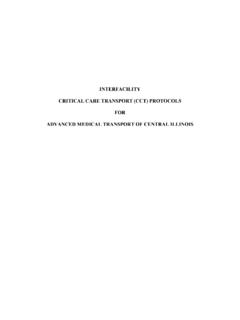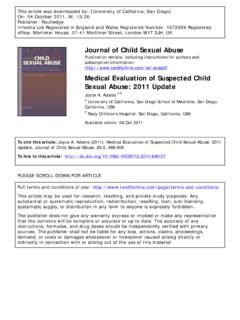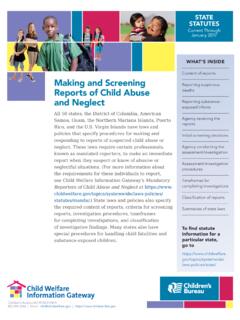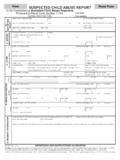Transcription of CHILD ABUSE AND NEGLECT POLICY & PROCEDURE …
1 CHILD ABUSE AND NEGLECT POLICY & PROCEDURE GUIDELINES/TOOLKIT D R A F T 20 ILLINOIS EMSC 1 CHILD ABUSE AND NEGLECT POLICY & PROCEDURE GUIDELINES/TOOLKIT Illinois Emergency medical Services for Children Second Edition, 2013 Illinois Emergency medical Services for Children is a collaborative program between the Illinois Department of Public Health and Loyola University Health System CHILD ABUSE AND NEGLECT POLICY & PROCEDURE GUIDELINES/TOOLKIT ILLINOIS EMSC 1 Table of Contents PAGE I. Acknowledgements .. 2 II. Introduction .. 3 III. CHILD ABUSE and NEGLECT POLICY and PROCEDURE Template.
2 5 Forms .. 9 1. Guidelines for Calling the CHILD ABUSE Hotline .. 9 2. Written Confirmation of Suspected CHILD ABUSE / NEGLECT Report: medical Professionals .. 11 3. Acknowledgement of Mandated Reporter Status .. 13 IV. Federal and State Regulations Related to CHILD ABUSE and NEGLECT .. 15 V. Resources .. 17 1. Suspected CHILD ABUSE / NEGLECT Algorithm .. 19 2. Pediatric Suspected Sexual Assault Overview .. 21 3. Pediatric Suspected Sexual Assault medical Evaluation and Management Guideline .. 23 4. Guidelines for Sexually Transmitted Infections (STI) Testing and Treatment .. 24 5. Table A. Behavioral and Physical Indicators of Potential ABUSE / NEGLECT .
3 25 6. Table B. Indicators of Potential CHILD Physical ABUSE .. 26 7. Table C. Differential Diagnosis of CHILD ABUSE : Conditions That May Be Mistaken for CHILD ABUSE .. 27 8. Table D. Differential Diagnosis of Sexual ABUSE : Conditions That May Be Mistaken for Sexual ABUSE .. 28 9. Table E. Indicators of Potential CHILD NEGLECT .. 29 10. Table F. CHILD ABUSE Mnemonic .. 30 11. Table G. ICD Coding for CHILD ABUSE / NEGLECT and Suspected CHILD ABUSE / NEGLECT .. 31 12. Table H. Identifying Children Who Live with Violence .. 33 13. Table I. Recognizing and Aiding Human Trafficking Victims .. 35 14. Sample Emergency Department Quality Improvement Monitoring Tool.
4 37 15. Sample Treatment Guideline: ED Systematic Screening and Detection of ABUSE .. 41 16. Sample Checklist for Potential CHILD ABUSE .. 43 17. Sample CHILD ABUSE and NEGLECT Screening .. 45 18. Developmental Milestones: Birth Through 5 Years .. 47 Your Baby at 2 Months .. 49 Your Baby at 4 Months .. 50 Your Baby at 6 Months .. 51 Your Baby at 9 Months .. 52 Your Baby at 1 Year .. 53 Your Baby at 18 Months .. 54 Your Baby at 2 Years .. 55 Your Baby at 3 Years .. 56 Your Baby at 4 Years .. 57 Your Baby at 5 Years .. 58 VI. References .. 59 VII. CHILD Maltreatment Weblinks .. 61 CHILD ABUSE AND NEGLECT POLICY & PROCEDURE GUIDELINES/TOOLKIT 2 ILLINOIS EMSC ACKNOWLEDGEMENTS The Illinois Emergency medical Services for Children (EMSC) Advisory Board gratefully acknowledges the commitment and dedication of the individuals and agencies involved in revising the CHILD ABUSE and NEGLECT POLICY and PROCEDURE Guidelines.
5 Their commitment and expertise has been invaluable, and their collective efforts are assisting the Illinois EMSC program to work toward the goal of improving pediatric emergency care within our state. Revision Ad-Hoc CommitteeChristina Frost, RN OSF Saint Francis medical Center, Peoria, IL Susan Fuchs, MD Ann and Robert H. Lurie Children s Hospital, Chicago, IL Nick Furtado, MD University of Illinois Hospital and Health Sciences System, Chicago, IL Jill Glick, MD The University of Chicago Medicine Comer Children s Hospital, Chicago, IL Anne Grote, RN Advocate Christ medical Center, Oak Lawn, IL Kathy Grzelak, LCPC Chicago Children s Advocacy Center, Chicago, IL Sheila Hickey, LCSW Ann and Robert H.
6 Lurie Children s Hospital, Chicago, IL Kathryn Janies, BA Illinois EMSC, Maywood, IL Denise Kane, PhD Office of Inspector General, Illinois Department of Children and Family Services, Chicago, IL Christine Kennelly, RN, MS Illinois EMSC, Maywood, IL Michele Lorand, MD John H. Stroger, Jr. Hospital of Cook County, Chicago, IL Evelyn Lyons, RN, MPH Illinois Department of Public Health, Maywood, IL Patricia Metzler, RN Carle Foundation Hospital, Urbana, IL Sharon O Connor, MS, MA Office of Inspector General, Illinois Department of Children and Family Services, Chicago, IL Meryl Paniak, MSW, JD Office of Legislative Affairs, Illinois Department of Children and Family Services, Joliet, IL Mary Clyde Pierce, MD Ann and Robert H.
7 Lurie Children s Hospital, Chicago, IL Glendean Sisk, RN, BSN, MPH Bureau Maternal & CHILD Health, Illinois Department of Human Services, Chicago, IL Illinois Emergency medical Services for Children has exercised extreme caution in assuring that all information presented is accurate and consistent with current practice as of the date of publication. The information does not serve as a substitute for an existing CHILD ABUSE and NEGLECT POLICY and PROCEDURE at your hospital. These guidelines may be modified at the discretion of the healthcare provider. Suggested citation: Illinois Emergency medical Services for Children (EMSC) CHILD ABUSE and NEGLECT POLICY and PROCEDURE Guidelines/Toolkit Second Edition 2013 Development of this document was supported in part by grant H33MC06685 from the Department of Health and Human Services, Maternal and CHILD Health Bureau.
8 CHILD ABUSE AND NEGLECT POLICY & PROCEDURE GUIDELINES/TOOLKIT ILLINOIS EMSC 3 INTRODUCTION CHILD ABUSE and NEGLECT are common sources of morbidity and mortality in childhood with devastating consequences. One out of every fifty-eight children in the United States (US) is a victim of CHILD ABUSE or NEGLECT affecting over one million children each year, resulting in irreversible and pervasive damage to our CHILD maltreatment is the leading cause of trauma-related death in children under four years of age accounting for 80% of all CHILD ABUSE ,3 In Federal Fiscal Year 2011, million referrals were made to CHILD Protection agencies nationally.
9 NEGLECT cases represented over 78% of these Annually, the Illinois Department of Children and Family Services (DCFS) CHILD ABUSE Hotline receives over 2 00,000 Unfortunately, the discovery of ABUSE is often made too late, with over 1,700 deaths, 18,000 permanent injuries, and 150,000 serious injuries3 occurring each year at an annual estimated direct and indirect cost of over $220 billion in the Whereas CHILD ABUSE is perceived as more prevalent, NEGLECT is actually the leading form of CHILD maltreatment. More children die from NEGLECT than from other physical ABUSE . Although NEGLECT is the most common, it is the least understood with regard to identification and intervention.
10 Morbidity and mortality results from failure to recognize early signs of CHILD ABUSE and NEGLECT . Up to 75% of ABUSE may be missed in acute care settings because signs are not W hen ABUSE is missed, repeat injury occurs in up to 80% of victims with mortality rates as high as 30%.3,8-12 Recent research indicates that many fatal or near-fatal abusive events could have been prevented had early signs of ABUSE been recognized and action ,13,14 Typically, children do not present with a chief complaint of CHILD ABUSE , hence the diagnosis can be very elusive. The emergency department (ED) has a formidable role in identifying and treating children with signs and symptoms of CHILD ABUSE and NEGLECT .







